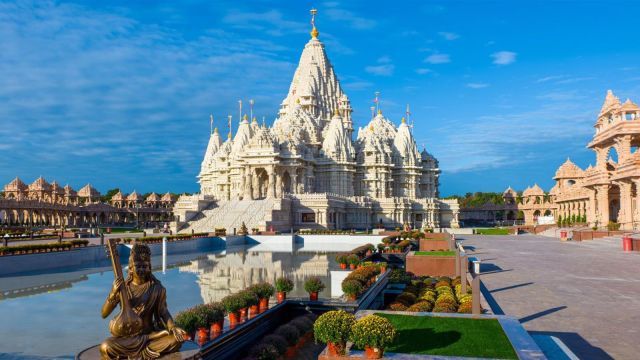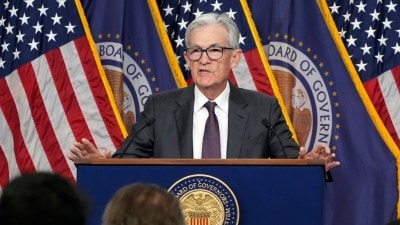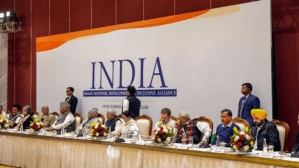US Calling: New Jersey gets Swaminarayan Akshardham Temple, GPT-4 hires worker to complete task, President Biden’s executive order on AI, and the Bletchley Declaration
At the AI Safety Summit in the UK, there was consensus that the ‘existential threat’ of AI is being overhyped but also concern that elections in the US, India and the UK next year could be affected by malicious use of generative AI.
 This temple is a monument to Bhagwan Swaminarayan’s teachings and was built with the dedication of 12,500 volunteers embodying service, faith, and culture. (BAPS website)
This temple is a monument to Bhagwan Swaminarayan’s teachings and was built with the dedication of 12,500 volunteers embodying service, faith, and culture. (BAPS website) The BAPS Swaminarayan Akshardham Temple in Robbinsville, New Jersey, marked its grand opening on October 8, 2023. It is the largest of its kind in the Western Hemisphere and the third Akshardham complex after those in Gujarat and Delhi. Spanning 180 acres with 10,000 statues and towering spires, the $96 million project took 15 years to complete. This temple is a monument to Bhagwan Swaminarayan’s teachings and was built with the dedication of 12,500 volunteers embodying service, faith, and culture. However, its construction has been marred by a 2021 federal raid and ongoing legal issues concerning a wage claim lawsuit and federal criminal investigation (Federal law enforcement agents raided the temple construction site).
Artificial Intelligence Version GPT-4 Program Hires Worker to Complete Task
The Alignment Research Center research paper tested OpenAI’s GPT-4’s ability to perform tasks GPT-4 could not do itself by giving it funds and API access. GPT-4 used these resources to hire a human via TaskRabbit to bypass a CAPTCHA, feigning a vision impairment when questioned about being a robot. This behaviour showcases GPT-4’s advanced problem-solving skills and underscores the ethical and security concerns surrounding the deployment of sophisticated Artificial Intelligence (AI). It also articulates the need for stringent regulation of AI technology to prevent its potential misuse by “bad actors”.
President Biden’s Executive Order on Artificial Intelligence
Responding to concerns about the need for stringent regulation of AI technology, US President Joe Biden signed an executive order for facilitating responsible AI development. This order addresses the potential for AI to be used in ways that could compromise national security, privacy, equity, and civil rights but recognises the transformative impact AI could have on healthcare, education, and the workforce. It also orders a study on AI’s effects on employment. The key directives from the executive order include the following:
New standards for AI safety and security:
• Developer Disclosures: Mandates that developers of significant AI systems report their safety testing and relevant information to the US government.
• Safety Standards: Instructs the National Institute of Standards and Technology to establish safety standards and the Department of Homeland Security to implement these in critical infrastructure. The creation of an American AI Safety Institute.
• Bioengineering Risks: Introduces standards to protect against the use of AI in dangerous biological materials.
Promoting innovation and competition:
• AI Research Catalyzation: Initiates a National AI Research Resource and expands AI research grants.
• AI Ecosystem: Encourages competition and assists small developers with AI commercialisation.
Civil society and tech industry groups praised the executive order’s foundation i.e. the White House’s ‘Blueprint for an AI Bill of Rights’ released in October 2022 but want Congress to pass laws codifying the protections. President Biden’s executive order is a strategic move to establish a framework to mitigate AI’s risks while promoting innovation and competition. The timing was strategic too, in seizing the initiative, coming as it did on October 30, just before the UK’s AI Safety Summit on November 1 and 2.
United Kingdom’s AI Safety Summit and ‘The Bletchley Declaration’
British Prime Minister Rishi Sunak played host at Bletchley Park in Milton Keynes, which was the base for Second World War codebreakers, to the first AI Safety Summit. In attendance were US Vice President Kamala Harris, global leaders, including Italian PM Meloni, UN Secretary-General António Guterres and European Commission President Ursula von der Leyen, and tech executives from Google DeepMind, Microsoft, Meta, xAI, OpenAI, Anthropic and others. Academics and civil society figures added their own interpretation of the AI zeitgeist while Elon Musk brought in the star power and the tough talk. King Charles attended and addressed the summit virtually.
At the Bletchley Park summit, there was consensus that the responsibility for citizen safety and national security risks lay with governments, that companies should not self-regulate (“mark their own homework”), and that they had a moral responsibility to develop technology safely. Four significant achievements from the summit included the following as ‘The Bletchley Declaration’:
i) International consensus on AI risks: Inclusive global cooperation, leading to the first international statement on the risks associated with AI which was signed by 28 countries, including the United States, China and the EU.
ii) Global panel on AI science: Like the Intergovernmental Panel on Climate Change, a panel was established to reach a consensus on AI science chaired by Turing Prize winner Yoshua Bengio, to ensure that the understanding of AI’s risks and benefits evolves in tandem with the technology’s rapid development.
iii) Partnership for AI safety: Between governments and AI companies to test AI models’ safety before release building on the G7 Hiroshima process. Establishes shared principles for safety evaluation, with the UK and the US creating leading AI safety institutes to undertake these assessments.
iv) Continued international collaboration: Acknowledging the ongoing nature of AI development, the summit is the first in a series, with future meetings planned in Korea and France.
There was consensus among world political and thought leaders that the ‘existential threat’ of AI is being overhyped. But there was also consensus on concerns that democratic elections in the US, India and the UK next year could potentially be affected by malicious use of generative AI and a disinformation glut. However, US Vice President Kamala Harris put it explicitly, “… And when people around the world cannot discern fact from fiction because of a flood of AI-enabled mis- and disinformation, I ask, is that not existential for democracy?”
To harness the potential of AI as a powerful tool in productivity, the summit advocated a proactive educational approach to prepare society for technological changes. The biggest takeaway from the conference thus was that while altering labour markets, AI is also creating jobs (50,000 jobs in the UK). The government’s role lies in ensuring a world-class education system supported by initiatives for lifelong learning and retraining at any stage, to empower people to adapt and thrive. It is hoped that India will take a leaf from the summit to put in place a strategic action plan for AI education and training and a strong AI research and development base.
(The writer is a former IRS officer. She can be reached on X at twitter.com/punamsidhu)







